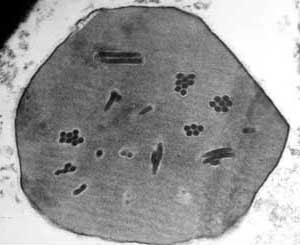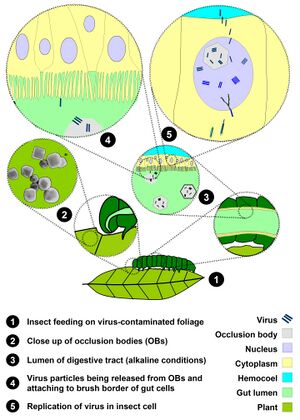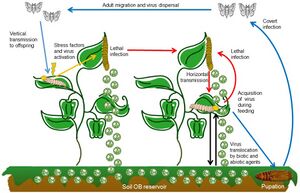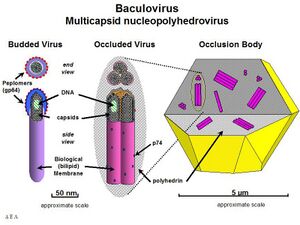فيروس عصوي
| Baculoviridae | |
|---|---|
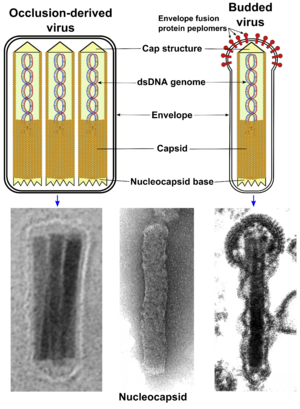
| |
| Baculovirus virions and nucleocapsids | |
| تصنيف الفيروسات | |
| أصنوفة غير معروفة (أصلحها): | Baculoviridae |
| Genera | |
|
Alphabaculovirus | |
الفيروسات العصوية إنگليزية: Baculovirus هي عائلة كبيرة من الڤيروسات . Arthropods, among the most studied being Lepidoptera, Hymenoptera and Diptera, serve as natural hosts. Currently, 85 species are placed in this family, assigned to four genera.[1][2][3]
والتي يمكن تقسيمها اٍلى جنسين:
- الفيروسات الحبيبية؛ لها قفيصة منواة واحدة في الغلاف الفيروسي
- nucleopolyhedroviruses؛ لها قفيصة منواة واحدة أو أكثر في الغلاف الفيروسي
Baculoviruses are known to infect insects, with over 600 host species having been described. Immature (larval) forms of lepidopteran species (moths and butterflies) are the most common hosts, but these viruses have also been found infecting sawflies, and mosquitoes. Although baculoviruses are capable of entering mammalian cells in culture,[4] they are not known to be capable of replication in mammalian or other vertebrate animal cells.
Starting in the 1940s, they were used and studied widely as biopesticides in crop fields. Baculoviruses contain a circular, double-stranded DNA (dsDNA) genome ranging from 80 to 180 kbp.
دورة الحياة
The baculovirus lifecycle involves two distinct forms of virus. Occlusion-derived virus (ODV) is present in a protein matrix (polyhedrin or granulin) and is responsible for the primary infection of the host. while the budded virus (BV) is released from the infected host cells later during the secondary infection.
Baculoviruses have very species-specific tropisms among the invertebrates with over 700 host species having been described. Immature (larval) forms of lepidopteran species are the most common hosts, but these viruses have also been found infecting sawflies and mosquitoes. Reports of baculovirus infections of shrimp and beetles (e.g. Oryctes rhinocerus) were found to be nudiviruses, a closely related lineage to the baculoviruses.
Typically, the initial infection occurs when a susceptible host insect feeds on plants that are contaminated with the occluded form of the virus. The protein matrix dissolves in the alkaline environment of the host midgut (stomach), releasing ODVs that then fuse to the columnar epithelial cell membranes of the host intestine and are taken into the cell in endosomes. Nucleocapsids escape from the endosomes and are transported to nucleus. This step is possibly mediated by actin filaments. Viral transcription and replication occur in the cell nucleus and new BV particles are budded out from the basolateral side to spread the infection systemically. During budding, BV acquires a loosely fitting host cell membrane with expressed and displayed viral glycoproteins.
After baculovirus infection, three distinct phases occur:
- Early (0–6 h),
- Late (6–24 h)
- Very late phase (18–24 to 72 h)
While BV is produced in the late phase, the ODV form is produced in the very late phase, acquiring the envelope from host cell nucleus and embedded in the matrix of occlusion body protein. These occlusion bodies are released when cells lyse to further spread baculovirus infection to next host. The extensive lysis of cells frequently causes the host insect to literally disintegrate, thus the reason for the historic name "wilting disease". The complete ODV-polyhedrin particles are resistant to heat and light inactivation, whereas the naked BV virion is more sensitive to environment.
When infecting a caterpillar, the advanced stages of infection cause the host to feed without resting, and then to climb to the higher parts of trees, including exposed places they would normally avoid due to the risk of predators. This is an advantage for the virus if (when the host dissolves) it can drip down onto leaves, which will be consumed by new hosts.[5]
الفيروسات العصوية لها ميول تجاه اللافقاريات بأكثر من 600 ثوي نوع محدد. أنواع العثة غير الناضجة (اليرقات ) هي المستضيفات الأكثر شيوعا، لكن هذه الفيروسات وجدة أيضا عند حشرة المنشار، البعوضيات و الروبيان.
بنية the virion
The most studied baculovirus is Autographa californica multicapsid nucleopolyhedrovirus (AcMNPV). The virus was originally isolated from the alfalfa looper (a lepidopteran) and contains a 134 kbp genome with 154 open reading frames. The major capsid protein VP39 together with some minor proteins forms the nucleocapsid (21 nm x 260 nm) that encloses the DNA with p6.9 protein.
التطبيقات
Baculovirus expression in insect cells represents a robust method for producing recombinant glycoproteins or membrane proteins.[6][7][8] Baculovirus-produced proteins are currently under study as therapeutic cancer vaccines with several immunologic advantages over proteins derived from mammalian sources.[9]
السلامة الحيوية
Baculoviruses are incapable of replicating within the cells of mammals and plants.[10] They have a restricted range of hosts they can infect that is typically restricted to a limited number of closely related insect species. Because baculoviruses are not harmful to humans, they are considered a safe option for use in research applications. They are also used as biological agents as in the case of the Indian mealmoth, a grain-feeding pest.[11]
التصنيف العلمي
The name of this family has been derived from the Latin word baculus, meaning "stick". The family has been divided into four genera: Alphabaculovirus (lepidopteran-specific nucleopolyhedroviruses), Betabaculovirus (lepidopteran-specific granuloviruses), Gammabaculovirus (hymenopteran-specific nucleopolyhedroviruses), and Deltabaculovirus (dipteran-specific nucleopolyhedroviruses).[12]
التطور
Baculoviruses are thought to have evolved from the Nudiviridae family of viruses .[13]
انظر أيضاً
- Cypovirus
- BacMam
- The Cobra Event
- Pancrustacea - clade including natural hosts of the viruses
- Early 35 kDa protein
المراجع
- ^ Harrison, RL; Herniou, EA; Jehle, JA; Theilmann, DA; Burand, JP; Becnel, JJ; Krell, PJ; van Oers, MM; Mowery, JD; Bauchan, GR; Ictv Report, Consortium (September 2018). "ICTV Virus Taxonomy Profile: Baculoviridae". The Journal of General Virology. 99 (9): 1185–1186. doi:10.1099/jgv.0.001107. PMID 29947603.
- ^ "Viral Zone". ExPASy. Retrieved 15 June 2015.
- ^ "Virus Taxonomy: 2020 Release". International Committee on Taxonomy of Viruses (ICTV). March 2021. Retrieved 12 May 2021.
- ^ Hofmann, C.; Sandig, V.; Jennings, G.; Rudolph, M.; Schlag, P.; Strauss, M. (1995). "Efficient Gene Transfer into Human Hepatocytes by Baculovirus Vectors". Proceedings of the National Academy of Sciences. 92 (22): 10099–10103. Bibcode:1995PNAS...9210099H. doi:10.1073/pnas.92.22.10099. PMC 40743. PMID 7479733.
- ^ Zimmer, Carl (November 2014). "Mindsuckers - Meet Nature's Nightmare". National Geographic.
- ^ Altmann, Friedrich; Staudacher, E; Wilson, IB; März, L (1999). "Insect cells as hosts for the expression of recombinant glycoproteins". Glycoconjugate Journal. 16 (2): 109–23. doi:10.1023/A:1026488408951. PMID 10612411. S2CID 34863069.
- ^ Kost, T; Condreay, JP (1999). "Recombinant baculoviruses as expression vectors for insect and mammalian cells". Current Opinion in Biotechnology. 10 (5): 428–33. doi:10.1016/S0958-1669(99)00005-1. PMID 10508635.
- ^ Madeo, Marianna; Carrisi, Chiara; Iacopetta, Domenico; Capobianco, Loredana; Cappello, Anna Rita; Bucci, Cecilia; Palmieri, Ferdinando; Mazzeo, Giancarlo; Montalto, Anna (2009-07-23). "Abundant expression and purification of biologically active mitochondrial citrate carrier in baculovirus-infected insect cells". Journal of Bioenergetics and Biomembranes (in الإنجليزية). 41 (3): 289–297. doi:10.1007/s10863-009-9226-6. ISSN 0145-479X. PMID 19629661. S2CID 44943721.
- ^ Betting, David J.; Mu, Xi Y.; Kafi, Kamran; McDonnel, Desmond; Rosas, Francisco; Gold, Daniel P.; Timmerman, John M. (2009). "Enhanced immune stimulation by a therapeutic lymphoma tumor antigen vaccine produced in insect cells involves mannose receptor targeting to antigen presenting cells". Vaccine. 27 (2): 250–9. doi:10.1016/j.vaccine.2008.10.055. PMC 2683685. PMID 19000731.
- ^ Ignoffo CM. (1975) Baculoviruses for Insect Pest Control: Safety Considerations, Summers M, Engler R, Falcon LA, Vail PV (eds.) American Society for Microbiology, Washington DC, p52
- ^ Sait, S.M.; Begon, M.; Thompson, D.J. (1994). "The Effects of a Sublethal Baculovirus Infection in the Indian Meal Moth, Plodia interpunctella". Journal of Animal Ecology. 63 (3): 541–550. doi:10.2307/5220. JSTOR 5220.
- ^ Jehle, JA; Blissard, GW; Bonning, BC; Cory, JS; Herniou, EA; Rohrmann, GF; Theilmann, DA; Thiem, SM; Vlak, JM; et al. (2006). "On the classification and nomenclature of baculoviruses: a proposal for revision". Arch Virol. 151 (7): 1257–1266. doi:10.1007/s00705-006-0763-6. PMID 16648963. S2CID 6293565.
- ^ Theze, J.; Bezier, A.; Periquet, G.; Drezen, J.-M.; Herniou, E. A. (2011). "Paleozoic origin of insect large dsDNA viruses". Proceedings of the National Academy of Sciences. 108 (38): 15931–5. Bibcode:2011PNAS..10815931T. doi:10.1073/pnas.1105580108. PMC 3179036. PMID 21911395.
للاستزادة
- Rohrmann, George (2019). Baculovirus Molecular Biology Fourth Edition (4th ed.). Bethesda, MD: NCBI.
- Federici, Brian A.; Granados, Robert R. (1986). The Biology of baculoviruses. Boca Raton: CRC Press. ISBN 978-0-8493-5988-0.
- Miller, Lois (1997). The baculoviruses. New York: Plenum Press. ISBN 978-0-306-45641-1.
وصلات خارجية
- ICTV Report: Baculoviridae
- Viralzone: Baculoviridae
- Index of Viruses – Baculoviridae (2006). In: ICTVdB – The Universal Virus Database, version 4. Büchen-Osmond, C (Ed), Columbia University, New York, USA. https://www.ncbi.nlm.nih.gov/ICTVdb/Ictv/fs_index.htm
- Rohrmann, G.F. 2019. Baculovirus Molecular Biology 4th Ed. https://www.ncbi.nlm.nih.gov/books/NBK543458/
- Rohrmann, G.F. 2019. Baculovirus Molecular Biology 4th Ed. https://ir.library.oregonstate.edu/concern/defaults/7d279043k?locale=en
}}
- Short description is different from Wikidata
- Automatic taxobox cleanup
- Articles containing إنگليزية-language text
- Pages using Lang-xx templates
- Pages with empty portal template
- Baculoviridae
- Biopesticides
- Diptera pests and diseases
- Insect viral diseases
- Virus families
- Mind-altering parasites
- ڤيروسات
- ڤيروسات ثنائية سلسلة الدنا
